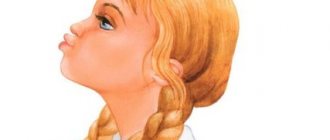Symptoms of rhinolalia
With open organic rhinolalia, the cause of which is various congenital anomalies, the baby’s vital functions such as breathing and nutrition suffer from the very first hours of his life.
As a rule, the sucking reflex in such children is preserved, but feeding becomes difficult, since the child does not latch on to the breast, and when bottle-fed, the mixture flows out through the nose, as a result of which the newborn does not receive the nutrients it needs and is significantly delayed in development. Since nasal breathing is impaired, such children often suffer from chronic inflammatory diseases of the respiratory system, which causes the development of rhinolalia. Among other things, congenital cleft palates are accompanied by various malocclusions, which only contributes to speech problems. This is often due to the fact that in such children the preservation of intelligence varies from normal to very significant developmental delays.
Speech development—both in the prelinguistic period and during the period of speech development—proceeds abnormally. There is no characteristic babbling. Or it is very quiet, barely noticeable. The child begins to pronounce his first words at the age of more than 2 years; his speech is illegible and slurred, and is difficult for others to understand.
With open organic rhinolalia, all sounds have a pronounced nasal connotation, and the child has impaired articulation and pronunciation of sounds. All consonants are more reminiscent of the sound “x”, they cannot be distinguished from each other. The voice is quiet and dull. Trying to pronounce sounds correctly, the child uses the facial apparatus or strains the muscles of the lips, wings of the nose or tongue, which only aggravates the situation.
Problems with speech also affect auditory perception and the ability to phonetically analyze spoken speech. In addition, due to limited communication with peers, these children have a rather poor vocabulary and have problems with written speech. The combination of such changes can lead to the fact that in a child with open organic rhinolalia, speech therapists are forced to note general speech underdevelopment. At the age when the child begins to realize his defect, changes in the speech apparatus are accompanied by various mental disorders and associated layers: isolation, irritability, shyness, etc.
In patients with open functional rhinolalia, the pronunciation of vowel sounds suffers to a greater extent. Such a child pronounces consonants quite well, which is associated with velopharyngeal closure that is quite sufficient for this. With closed functional rhinolalia, as a rule, only the timbre of the voice suffers, which takes on an unnatural, dull, “dead” hue.
Closed organic rhinolalia is characterized by distortion of consonant sounds. The child often changes the sound “m” to the sound “b”, “n” to “d”, etc. With this form of pathology, nasal breathing is difficult, and therefore the child constantly breathes through the mouth, which leads to the fact that such children are susceptible to various inflammatory diseases of the upper respiratory tract, and also often suffer from chronic forms of bronchitis and pneumonia, which have a recurrent course.
Scheme of examination of children with rhinolalia; methodological development in speech therapy
SCHEME FOR EXAMINATION OF CHILDREN WITH RHINOLALIA
1. Personal details
2. History.
3. At what age did you undergo surgery, for what defect (cleft of the hard, soft palate, unilateral, bilateral cleft, etc.).
4. Structure of the articulatory apparatus. You should have an otolaryngologist's opinion on the state of auditory function, nasal, oral cavities, and larynx; dentist and orthodontist about the condition of the dental system, pathology of the lips, palate, palatine vault, tongue, as well as, if necessary, the conclusion of a psychoneurologist, physiotherapist, pediatrician, physical therapy doctor. Regardless of the completeness of the conclusion, the speech therapist carefully examines the structure and function of the articulatory apparatus:
§ the length of the velum (the speech therapist uses a spatula to try to bring the edge of the soft palate to the back wall of the pharynx, holding the protruding tongue with a gauze napkin);
§ the shape of the palatine vault (attention is drawn to the too high, Gothic vault of the palate or, conversely, to the too low);
§ the presence of postoperative scars in the area of the hard and soft palate, lips, cleft palate, postoperative fistulas, cracks;
§ presence of malocclusion (progenia, prognathia, open anterior or lateral bite, dental anomalies);
§ anomalies in the structure of the lips (is there a cleft, its type, character, formation of the lip after cheiloplasty);
§ pathology in the structure of the tongue (shortening of the hyoid ligament, too thick or thin tongue, etc.).
5. Motility of the articulatory apparatus. When examining the function of the articulatory apparatus, attention is paid not only to the mobility of the lips, tongue, jaw, but above all:
§ on the mobility of the soft palate, which is tested by energetically repeating the sound “a”. The baby's mouth should be wide open;
§ the presence of velopharyngeal closure, its type and nature (passive, active, functional closure of the velum palatine with the posterior wall of the pharynx);
§ the state of facial muscles, the presence of accompanying movements (furrow the eyebrows, raise them up, wrinkle the forehead; close the right and left eyes; inflate the right, then the left cheek, then both cheeks at the same time).
When examining the function of the articulatory apparatus, attention is paid to the volume (full, incomplete) and quality of movements (motor tension, motor activity, disinhibition) of the lips, tongue, lower jaw, soft palate; the ability to accurately and for a long time hold them in a given articulatory vine; the ability to smoothly switch from one movement to another; exhaustion from movement; the presence of snkinesia (friendly movements accompanying the main thing: eyes squinting, cheeks twitching, etc.).
6. Type and nature of physiological and speech breathing:
§ upper clavicular, thoracic, diaphragmatic;
§ breathing at rest, type of breathing, depth and strength;
§ speech breathing, its type and strength, duration of speech exhalation, presence of air leakage through the mouth during phonation.
7.Voice function:
§ sound strength (pronunciation of vowel sounds, syllables, words, phrases from a whisper to a full voice is proposed: whisper, quiet voice, medium volume, loud, gradually strengthening or weakening the voice);
§ voice pitch (pronunciation of vowel sounds, syllables, words with a raised or lowered voice, singing scales);
§ voice timbre (attention is paid to the degree of nasalization during the isolated pronunciation of sounds, as well as in the speech stream).
8. Sound-pronounced. When examining sound pronunciation, attention is paid to phonetic and phonetic-phonemic defects (missing, replaceable, distorted, mixed sounds are recorded). The examination begins with vowel sounds and is carried out in the following order: a, e, o, s, u, i, i, e, e, yu. Next, the nature of the articulation of all consonant sounds is examined: s, z, c, sh, zh, h, shch, r, l, k, g, x, p, b, t, d, f, v, m, n (their soft pairs).
9. Hearing function:
§ state of physical hearing;
§ state of phonemic hearing, analysis and synthesis.
10. The general nature of the activity of the speech apparatus during the speech process. Does the child open his mouth well, is articulation expressive, what is the activity in the speech process of the lips, tongue, cheeks, frontal muscles, the presence of synkinesin.
11. Prosodic side of speech. Pay attention to the pace (normal, fast, slow); rhythm (normal, arrhythmia); preservation of pauses in the flow of speech (norm, division of words); loudness, intelligibility, emotional expressiveness.
12. Vocabulary and grammatical structure of speech. When examining the dictionary, you need to examine the active and passive vocabulary in quantitative and qualitative terms, and pay attention to the formation of the syllabic structure of the word. When examining the grammatical structure of speech, pay attention to the nature of the sentences used (common, uncommon), the sequence of words in the sentence (corresponds to the grammatical norm or not), the state of the inflection and word formation function.
13. Written speech.
14. Mental state.
15. Conclusion about the state of speech. It is necessary to indicate the form of rhinolalia: open, closed, mixed; the nature of the violation of sound pronunciation and lexico-grammatical aspects of speech. For example, open rhinolalia, phonetic defect; open rhinolalia, complicated by general speech underdevelopment (level III).
Diagnosis of rhinolalia
The examination of children and adults with rhinolalia is multifaceted and is carried out by various specialists:
- otolaryngologist;
- speech pathologist;
- speech therapist;
- neurologist;
- orthodontist;
- phoniatrist;
- pediatrician
An examination by specialized specialists allows us to identify the etiology of the disease, characterize as accurately as possible the nature of pathological changes and the severity of all symptoms. The following instrumental diagnostic methods are important:
- X-ray of the nasopharynx;
- rhinoscopy;
- electromyography;
- pharyngoscopy, etc.
These techniques make it possible to visualize the nature of pathological changes and their severity in each individual patient.
Of course, the most significant is an examination by a speech therapist, who, using a number of progressive techniques, will be able to assess the following parameters:
- structure of the articulatory apparatus;
- his mobility;
- voice disorders;
- parameters of physiological and phonation breathing, etc.
To diagnose open rhinolalia, the Gutzmann technique is used, which is based on the fact that the patient pronounces the sounds “a” and “i” alternately, while the doctor opens and closes the nasal passages. In the presence of pathological changes, the vibration of the wings of the nose is very clearly felt, and when the nasal passages are pinched, the sounds are significantly muffled. Thus, it is possible to diagnose the open form of rhinolalia.
Cause of rhinolalia
Rhinolalia usually occurs in an open form. It occurs when there is a split in the hard and soft palate, the alveolus of the lip, or the upper part of the entire speech apparatus. The causes of the pathology are caused by various highly pathogenic effects on the embryo in the period between the 5th and 8th weeks of development.
Typically, the reasons for such effects are associated with problems of the mother’s body during pregnancy such as:
- Flu;
- Mumps;
- Toxoplasmosis;
- Rubella;
- All kinds of endocrine disruptions;
- Abuse of bad habits (alcohol, smoking, etc.);
- ENT disorders in the fetus.
- The causes of the appearance of a closed form of rhinolalia are usually:
- Deviation of the nasal septum;
- Fibroids;
- Polyps;
- Tumors;
- Critical proliferation of adenoids.
Correction of rhinolalia
Correction of rhinolalia should have a comprehensive approach. As a rule, congenital anomalies of the structure of the facial skull are subject to surgical correction. Congenital defects are corrected using plastic surgery. Such operations are aimed at restoring the anatomical structure of the organs of the nose and pharynx, as well as eliminating cosmetic defects.
In addition, some patients require surgical interventions to remove nasal polyps, adenoids and other pathological formations that interfere with normal nasal breathing. Correction of the bite and deformations of the upper jaw by an orthodontist is also required. Physiotherapy, special speech therapy sessions, and psychotherapy also play a significant role in the treatment process.
Rhinolalia is a complex and very diverse disease, the successful treatment of which requires the participation of specialists from many areas of modern medicine. In particular - speech therapy, dental surgery, otolaryngology, orthodontics, psychology.
Treatment and diagnosis
Doctors such as speech therapist, speech therapist and neuropsychiatrist are involved in the examination and development of treatment strategy for the treatment of childhood speech dysfunction caused by rhinolalia. Since the symptoms of the pathology are quite extensive and are caused by various reasons, in the treatment of rhinolalia there may be a need for the services of an orthodontist, dentist, otolaryngologist, and in some particularly severe cases, a plastic maxillofacial surgeon.
A defectologist and speech therapist are responsible for diagnosing the state of development of the speech and cognitive sphere of a child with rhinolalia, as well as developing developmental teaching methods. A child with rhinolalia is usually prescribed articulation exercises and exercises to develop phonemic hearing, speech therapy massage and breathing exercises.



